
Approval voting is a single-winner electoral system in which voters mark all the candidates they support, instead of just choosing one. The candidate with the highest approval rating is elected.
Plurality voting refers to electoral systems in which the candidate in an electoral district who poll more than any other are elected.
Proportional representation (PR) refers to any type of electoral system under which subgroups of an electorate are reflected proportionately in the elected body. The concept applies mainly to political divisions among voters. The essence of such systems is that all votes cast – or almost all votes cast – contribute to the result and are effectively used to help elect someone. Under other election systems, a bare plurality or a scant majority are all that are used to elect candidates. Further, a PR system is one that produces mixed and balanced representation, reflecting how votes are cast.

The two-round system, also called ballotage, top-two runoff, or two-round plurality, is a voting method used to elect a single winner. In the United States, it is often called a jungle or nonpartisan primary. It is sometimes called plurality runoff, although this term can also be used for other systems.

The single transferable vote (STV), a type of proportional ranked choice voting (P-RCV), is a multi-winner electoral system in which each voter casts a single vote in the form of a ranked-choice ballot. Voters have the option to rank candidates, and their vote may be transferred according to alternative preferences if their preferred candidate is eliminated or elected with surplus votes, so that their vote is used to elect someone they prefer over others in the running. STV aims to approach proportional representation based on votes cast in the district where it is used, so that each vote is worth about the same as another.
Single non-transferable vote or SNTV is an electoral system used to elect multiple winners. It is a semi-proportional variant of first-preference plurality, applied to multi-member districts where each voter casts just one vote. SNTV generally makes it unlikely that a single party will take over all seats in a city, as generally happens with winner-take-all systems. SNTV is highly similar to cumulative voting, and can be considered a variant of dot voting where each voter has only one point to assign.
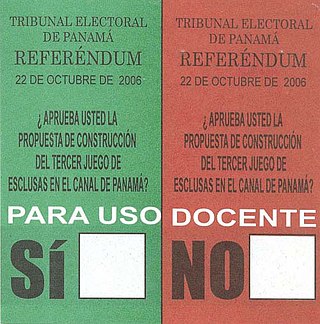
Voting is a method by which a group, such as a meeting or an electorate, convenes together for the purpose of making a collective decision or expressing an opinion usually following discussions, debates or election campaigns. Democracies elect holders of high office by voting. Residents of a jurisdiction represented by an elected official are called "constituents", and the constituents who choose to cast a ballot for their chosen candidate are called "voters." There are different systems for collecting votes, but while many of the systems used in decision-making can also be used as electoral systems, any which cater to proportional representation can only be used in elections.
Block or bloc voting refers to a class of electoral systems where multiple candidates are elected simultaneously. They do not guarantee minority representation and allow a group of voters to ensure that only their preferred candidates are elected. In these systems, a voter can select as many candidates as there are open seats. That is, the voter has as many votes to cast as the number of seats to fill. The block voting systems are among various election systems available for use in multi-member districts where the voting system allows for the selection of multiple winners at once.

The 1926 Alberta general election was held on June 28, 1926, to elect members of the Legislative Assembly of Alberta. The United Farmers of Alberta government that had first been elected in 1921 was re-elected, taking a majority of the seats in the Alberta Legislature. Herbert Greenfield had resigned as United Farmers leader and premier, and John E. Brownlee led the UFA to this second election victory, increasing the UFA's number of seats.
In electoral systems, a wasted vote is any vote cast that is not "used" to elect a winner, and so is not represented in the outcome. However, the term is vague and ill-defined, having been used to refer to a wide variety of unrelated concepts and metrics. The precise definition of a wasted vote can have a major impact on the conclusions of an analysis. For example, under the narrowest possible definition of a wasted vote, the single transferable vote (STV) can be considered to waste zero votes. However, if the wasted vote definition is expanded even slightly, it is possible for up to 100% of STV votes to be classified as wasted because STV fails the unanimity criterion; that is, it is possible to elect a legislature that every single voter agrees is worse than some alternative.
BC-STV is the proposed voting system recommended by the Citizens' Assembly on Electoral Reform in October 2004 for use in British Columbia, and belongs to the single transferable vote family of voting systems. BC-STV was supported by a majority of the voters in a referendum held in 2005 but the government had legislated that it would not be bound by any vote lower than 60 percent in favour. Because of the strong majority support for BC-STV, the government elected to stage a second referendum in 2009, but with increased public funding for information campaigns to better inform the electorate about the differences between the existing and proposed systems. The leadership of both the "yes" side and the "no" side were assigned by the government. The proposal was rejected with 60.9 percent voting against, vs. 39.1 percent in favour, in the 2009 vote.
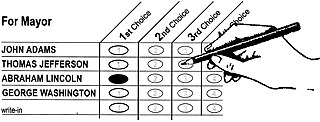
Bullet, single-shot, or plump voting is when a voter supports only a single candidate, typically to show strong support for a single favorite.
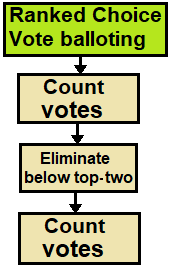
The contingent vote is an electoral system used to elect a single representative in which a candidate requires a majority of votes to win. It is a form of preferential voting. The voter ranks the candidates in order of preference, and when the votes are counted, the first preference votes only are counted. If no candidate has a majority of the votes cast, then all but the two leading candidates are eliminated and the votes received by the eliminated candidates are distributed among the two remaining candidates according to voters' preferences. This ensures that one candidate achieves a majority and is declared elected.
There are a number of complications and issues surrounding the application and use of single transferable vote proportional representation that form the basis of discussions between its advocates and detractors.
Multiple transferable voting, sometimes called block preferential or block instant-runoff voting, is a winner-take-all system for electing several representatives from a multimember constituency. Unlike single transferable voting (STV), preferential block voting is not a method for obtaining proportional representation, and instead produces similar results to plurality block voting. Preferential block voting can be seen as a multiple-winner version of instant-runoff.
Block plurality voting is a winner-take-all method for multi-winner elections. Each voter may cast as many votes as the number of seats to be filled. The usual result when the candidates divide into parties is that the most popular party in the district sees its full slate of candidates elected.
Instant-runoff voting (IRV), also known as ranked-choice voting or the alternative vote (AV), combines ranked voting together with a system for choosing winners from these rankings by repeatedly eliminating the candidate with the fewest first-place votes and reassigning their votes until only one candidate is left. It can be seen as a modified form of a runoff election or exhaustive ballot in which, after eliminating some candidates, the choice among the rest is made from already-given voter rankings rather than from a separate election. Many sources conflate this system of choosing winners with ranked-choice voting more generally, for which several other systems of choosing winners have also been used.
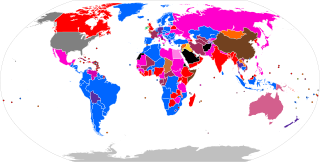
An electoral or voting system is a set of rules used to determine the results of an election. Electoral systems are used in politics to elect governments, while non-political elections may take place in business, non-profit organisations and informal organisations. These rules govern all aspects of the voting process: when elections occur, who is allowed to vote, who can stand as a candidate, how ballots are marked and cast, how the ballots are counted, how votes translate into the election outcome, limits on campaign spending, and other factors that can affect the result. Political electoral systems are defined by constitutions and electoral laws, are typically conducted by election commissions, and can use multiple types of elections for different offices.
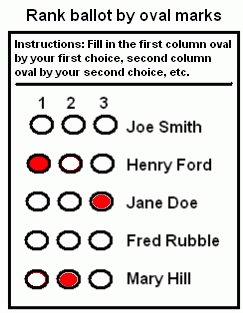
Ranked voting is any voting system that uses voters' orderings (rankings) of candidates to choose a single winner or multiple winners. Many ranked voting systems apply lower preferences just as contingency choices when higher preferences are found to be ineffective or the vote or part thereof needs to be transferred on in cases where higher preference was elected.
The mixed ballot transferable vote (MBTV) refers to a type of vote linkage-based mixed-member electoral system where a group of members are elected on local (lower) tier, for example in single-member districts (SMDs). Other members are elected on a compensatory national (upper) tier from a list and voters cast a single ballot where they may indicate their preferences separately.









